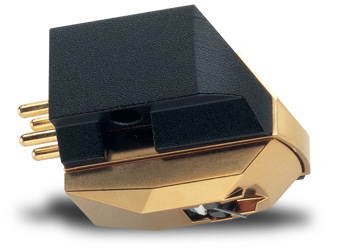![[SoundStage!]](../sslogo3.gif) The Vinyl Word The Vinyl WordBack Issue Article |
|||||||||||||||||||
November 2007 Audio-Technica AT-OC9ML/II Phono Cartridge
But many swear that nothing comes closer to reproducing the sonic truth embedded in those vinyl grooves than a low-output moving-coil cartridge. Usually, though, there are a couple of reasons why many shy away from MC cartridges. They are expensive and require a top-grade, expensive phono stage that can handle the very low output (anywhere from 0.2 to 0.6mV.). Yes, the low output does require a phono stage that is specifically built to provide adequate gain, and do so quietly. However, most separate phono stages available these days have that capability, so the cartridge's low output isn’t so much of a handicap anymore. But cost can be. If you read the audiophile press, you get the feeling that to enter the acceptable, entry-level moving-coil-cartridge arena requires that you to shell out a thousand dollars or more. That's a bundle of dough for most -- especially for those just getting into vinyl. Companies like Audio-Technica understand this and have continued to build cartridges like the AT-OC9ML/II. It's a low-output moving-coil cartridge whose low cost -- $599 USD, but available for as little as $289 -- and high-end sound have made it a favorite of audiophiles on a budget. Does it deserve its reputation? Let's find out. Description The AT-OC9ML/II is a squarish, metal-bodied cartridge with a tapered front. It weighs in at a reasonable 8 grams. The mounting is half-inch, and it should be compatible with most medium-mass tonearms. The cartridge body does not have threaded mounting screw holes, so beware mounting it with those small, easily lost nuts. The stylus is what Audio-Technica calls a "Nude Square Shank MicroLine." It is mounted on a gold-plated boron cantilever, which is mainly used for much more expensive cartridges due to the difficulty in working with the material. The AT-OC9ML/II's frequency response is stated as 15Hz-50kHz, and its channel separation is 31/21 (dB @ 1kHz/10 kHz). The recommended vertical tracking force is between 1.25 and 1.75 grams -- I split the difference and set it at 1.5 grams. Recommended load impedance is 20 ohms; my Audio Research PH5 phono stage only goes down to 100 ohms, so that’s where I set it for the duration of the review. Output is a reasonable 0.4mV @ 1 kHz., and channel balance is 1.0dB. System I installed the AT-OC9ML/II at the business end of my Butternut Audio-modified Rega RB300 tonearm, which is attached to a VPI HW-19 Mk IV turntable. The 'table uses Michell Tenderfeet cones atop a 2" slab of Boos Brothers butcher-block maple on a Salamander Archytype stand. The phono stage is an Audio Research PH5 run single-ended into an Audio Research LS17 line-stage preamp. The preamp is run balanced into a Bryston 4B SST power amp, which is biwired to a pair of Magnepan MG1.6 speakers. Interconnects and speaker cables are Analysis Plus Solo Crystal Oval. Power cords are from Harmonic Technology or Analysis Plus. Accessories used were a Hunt/EDA carbon-fiber brush, a VPI HW-16.5 record-cleaning machine, and a Furutech deStat anti-static device. I used my Clearaudio Maestro moving-magnet cartridge for comparison. Sound Whiplash! My neck hurt from all of the times I spun my head around while I listened with the AT-OC9ML/II in my system. Even with my most familiar records, the speed, agility and articulation were far beyond anything I’d previously heard. Each transient’s leading edge had snap, making drum rolls or the initial strike on a piano’s keyboard or a guitar string sound so realistic that I could have sworn someone had sneaked those instruments into my listening room. The bloom and decay of those notes could have trailed off a bit longer, but given the price of the AT-OC9ML/II, the sound was all I could ask for. The frequency extremes went as high and low as my speakers allowed -- and probably would have extended even further had my Maggies been up to the task. The treble was neither forward nor recessed, staying in the middle in terms of perspective. Only a bit of wiriness at the very top hinted at the AT-OC9ML/II's affordable origins. Bass was deep but lacked some weightiness, though retrieval of low-end detail was excellent. Charles Mingus’s bass on Mingus Ah Um [Columbia CS 8171] was portrayed with excellent definition. There was also an exceptional sense of air and space around the instrument that made me sit up and take notice. The AT-OC9ML/II added bite to brass and definition to drums and bass instruments. For an excellent example, listen to the superb new reissue of Mingus Dynasty [Pure Pleasure/Columbia CS 8236], especially "Gunslinging Bird." To achieve this, the AT-OC9ML/II doesn't tip over to the lean, cool side of neutral, for that would be an added coloration. This cartridge may fall just on that side of the sonic spectrum, but it sounds far more even-handed than not. While the AT-OC9ML/II would be perfect in a system that's warm and rich, I’d recommend giving it a listen no matter the sound of your system. It’s that good.
Soundstaging was top-notch, especially for such an inexpensive cartridge. I heard a sense of both how wide and deep an orchestra was spread out as well as where each section was in relation to the others. No, the AT-OC9ML/II didn’t carve out each musician in their own space with the utmost precision, but it still let me know whether I was hearing a large group of musicians or a small one. This came via the ability to extract a great amount of small-scale detail from each album -- greater than I’ve previously heard from any cartridge I’ve owned. Another strong point of the AT-OC9ML/II was its ability to track -- to stay in the groove and extract as much information from it as possible. It was also quiet, making listening to any record I placed on the platter of my VPI turntable a true joy. Given that the bulk of LPs in most collections will be older -- perhaps many having been purchased used -- the AT-OC9ML/II ’s ability to keep groove noise to something far less than a dull roar is a far bigger bonus than you might think, and a factor that you shouldn’t overlook if you’re shopping for a mid-priced cartridge. I loved the AT-OC9ML/II’s way with vocals, especially female. From the gruff, folksy sounds of Harry Chapin (Verities & Balderdash [Elektra 7E-1012]) to the subtle, delicate singing of Norah Jones (Feels Like Home [Classic/Blue Note 7243 5 84800 1 6]), the AT-OC9ML/II brought great presence to any vocal recording I played. Each singer displayed his or her particular characteristics -- there was no editorializing. This is an impressive enough trait in mega-buck cartridges, but to find it in one whose street price is as low as the AT-OC9ML/II's is downright amazing. The AT-OC9ML/II made me question whether spending more money on a higher-priced moving-coil cartridge is really necessary. The darned law of diminishing returns kicks in sooner with moving-coil cartridges than with most high-end equipment -- thanks to the AT-OC9ML/II. I listened to many, many different records over the course of this review, and not one of them was anything less than exciting and effervescent when the AT-OC9ML/II was sliding through its grooves. It made my records come alive with musical detail that previous cartridges passed by without so much as a wink or nod. While not perfect, it certainly offered up more than a taste of what a good moving-coil cartridge is capable of for less than its sonic competition. Or, to put it another way, mounting the AT-OC9ML/II on your tonearm is like winning the lottery with your very first ticket. You can’t believe your luck. Comparison Comparing my top-of-the-line Clearaudio Maestro moving-magnet ($1000) and the AT-OC9ML/II moving-coil cartridges was, to say the least, illuminating. Where the AT-OC9ML/II was light on its feet and speedy, the Maestro was weightier and hit harder. The AT-OC9ML/II delved deeper in the dark spaces of the grooves, dredging up many low-level details that the Maestro glossed over. It was fleet, quick, and agile, and it offered far more in the way of air and space. It made familiar LPs come alive. What it lacked was a fullness of image -- a bit more flesh on the bone, if you will -- that would have gone a long way toward making it sound more realistic. But that, I would imagine, is the providence of more expensive moving-coil cartridges. The Clearaudio Maestro lacked the AT-OC9ML/II’s ability to dance quite as quickly and gracefully through the records grooves, but it offered a completely different, though no less valid, perspective. While it couldn’t convey all the detail, air and space that the AT-OC9ML/II managed to extract seemingly at will, it could put a more solid foundation under all sonic aspects, allowing the music to stand more firmly planted in my listening room. Plus, those images had a solidity that the AT-OC9ML/II, as good as it was, just could compete with. Both cartridges excelled at making music come alive, but they did so in vastly different manners. Which is correct? Ah, there we enter the realm of subjectivity. What I can say is that having heard the AT-OC9ML/II, I now have a healthier respect for those who say that there is nothing like a good moving-coil cartridge. It completely blew me away that a cartridge that cost half the price of my Clearaudio Maestro could compete with it, and in a number of ways surpass it. The AT-OC9ML/II certainly gives those in the market for a high-quality cartridge a reason to think before laying down their money for a cartridge that costs considerably more. End game If you’ve always wondered what a good moving-coil cartridge sounds like, don’t want to spend a bundle to find out, and have the equipment to handle its low output, then by all means pick up an Audio-Technica AT-OC9ML/II. It is a worthy first step on the journey into the realm of the moving-coil cartridges, one that makes all the magic happen every time you play your records. Its quickness into and out of each note, its ability to portray space, and its bass detail are very endearing, no matter its price. At the end of my listening to AT-OC9ML/II, I was struck by just how good this inexpensive moving-coil cartridge is. It offers many, many virtues and few shortcomings, and its recommendation is a no-brainer. The AT-OC9ML/II sets a standard that will be hard for any cartridge, moving magnet or moving coil, to match at its price. It has become this reviewer’s choice for entry into the world of moving-coil cartridges. ...John Crossett
|
|||||||||||||||||||
|
|||||||||||||||||||
![[SoundStage!]](../sslogo3.gif) All Contents All ContentsCopyright © 2007 SoundStage! All Rights Reserved |


